At 6,500 years older than Stonehenge and 7,000 years before the pyramids were constructed, a cult megalithic complex sat atop the hills near current day Sanliurfa, in southeast Turkey. Göbekli Tepe was flourishing an astonishing 12,000 – 14,000 years ago, and today, the preserved remains still exhibits high degrees of sophistication and megalithic engineering skill. Back in the 1990’s when Robert Schoch exclaimed that the Sphinx could be many thousands of years older than previously thought, he was ridiculed. Graham Hancock’s popular theories of an 12,000 year old Ice-age civilization were slammed. Now today, there stands a unique, and remarkably ancient complex that is shaking the foundations of science and history, awakening an interest in our human origins, and has been carbon-dated by German archaeologists to the end of the last ice-age. Game on.
In September 2013, I had the opportunity to go and see Göbekli Tepe for myself. I joined forces with authors Andrew Collins and Graham Hancock on a Megalithomania expedition around Turkey to investigate this enigmatic discovery. It was Graham’s first time there too, and will be documented in his forthcoming Book – ‘Magicians of the Gods’. Graham was as astonished as I was. For such an old structure, the quality of stonework and abstract artistic skill, just seems like it should not exist. American archaeologist Peter Benedict first discovered something was going on there in 1963, noticing prehistoric flints all over the area. He also discovered some broken fragments of beautifully crafted T-shaped blocks with relief carvings on. However, due to the superior quality of the stonework, they were classified as Byzantium artifacts (1) . Interestingly one of the stones that is now on display in Urfa museum, looks conspicuously like one I had previously seen in Peru. In 1994 a german archaeologist, Klaus Schmidt, recognised the site as part of the ‘pre-pottery neolithic’ culture because this style of carving was similar to a site he had worked at earlier – Nevalı Çori. A year later, excavations began, although the general public did not hear about it until the year 2000, when it was documented in a German magazine.
What strikes people when they visit this site is the intricacy of the stonework, the size of the megalithic pillars, and the sheer magnitude of the man-made hill it was carefully covered with. The original construction was built on solid bedrock, then mounds were constructed on top of these, and further structures built on top over a period of around two thousand years, with the final enclosures containing smaller stones and less sophistication than the earlier levels. The larger, older pillars at the lower levels, show bas-relief carvings of various animals, reptiles, birds and serpents. Some pillars seem to represent strange, abstract statues of humans, wearing space-age belts, with long, bent arms and ‘H’ type letters (on every pillar in enclosure D). Most impressive is a strange creature in three dimensional high-relief showing beautiful craftsmanship and originality (for that period). So there are three types of relief carvings at Göbekli Tepe. The 3D high-relief, the shallow reliefs of animals, ‘H’s, and the humanoid arms and belts, plus a rougher style that occurs on the later levels, although incredibly, this still dates to around 8,000 years old.
I found the shaping of the pillars interesting too. Why choose such a specific design? An abstract construction that sits gently on the bedrock, in very shallow pits. Some of the pillars are 18ft high, with the top part of the ‘T’ carved to look like it is a separate block to the main pillar, although it it actually one piece. There are finely carved rims and shaping that reminded me of Tiwanaku in Bolivia. The largest limestone pillar is still in the nearby quarry, that is a staggering 24ft long. Another interesting aspect of the site are the unusual cup-marks that are found, mainly on the bedrock, but also on top of some of the oldest pillars, that may at some point, shed some light on the cup-mark phenomenon in Britain, many thousands of years later.
As part of the expedition, we also visited a Hittite site called Alaca Höyük, near Ankara, the modern capital city of Turkey. It earliest inhabitants were the Hattians, who were earth-based goddess worshipers, with roots in the stone-age, who flourished from around 2350 BC to 1700 BC. Although much younger than Göbekli Tepe, the megalithic walls are indistinguishable from polygonal walls found all over Peru. The jigsaw, irregularly shaped blocks, with some weighing in at more than twenty tons apiece are a unique style that were once thought to only exist in that part of South America, but on my travels I have seen them all up the west coast of Italy, on Easter Island, and in Egypt, plus they have been photographed in Delphi, Greece, Albania, Saudi Arabia, and Japan. Although separated by many millennia and vast distances, this style is possibly the most difficult style to accomplish, as each block needs to be carved extremely accurately so they fit together and stay together over the years, even through earthquakes. But at Alaca Höyük, and nearby Hattusu, they are not flat-faced walls, they look ‘puffy’, basically protruding from the joins, that some researchers say look like ‘pillows’. It’s a very childlike style, that does not seem to follow any particular plan, but it was a popular technique favoured by the ancient megalith builders. This begs the question, was there a global megalithic stonemason elite in prehistory? Did they diffuse this influence around the world and construct specific sites? And with so many similarities to sites in Peru and Bolivia, there was only one thing to do.
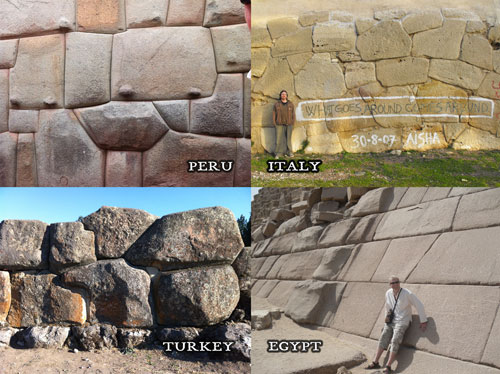
Top left: Cuzco, Peru. Top right: Western Italy. Bottom left: Alaca Hoyuk, Turkey. Bottom right: Casing stones on pyramid on Giza plateau.
Fortunately, I was co-organising a Megalithomania trip to Peru and Bolivia in November 2013 with David Hatcher Childress and Brien Foerster. David had just published a book called ‘Ancient Technology in Peru and Bolivia’ (Adventures Unlimited Press), and Brien has been studying the sites for 6 years. It was the perfect team to try and get some answers to this prehistoric mystery, and look out for any clues that these ancient cultures might be connected.
On the flight to Lima, I looked carefully through my film footage and photographs from Costa Rica, where I had visited the previous December (2012). I went there mainly to investigate the enigmatic stone spheres, but while I was in the San Jose Museum, I was struck by some other intricate stone items on display. There are some beautifully engineered animal reliefs on some 8ft – 9ft rectangular stone slabs. that were only a few inches thick. Around the edges of some of them, there were remarkable carvings, that jump out at you in 3D. My attention was also drawn to a strange ghostly statue at one end of the museum. It had gormless eyes, broad shoulders and hands reaching towards the navel. The significance of these items did not jump forth until I had visited Sanliurfa museum (near Göbekli Tepe) nine months later. There, a famous discovery stands on display. ‘Urfa Man’ is just over 6ft tall with similar features to his doppelganger in Costa Rica. The ‘Balikligöl Statue’ (as it is officially called) was found near the ancient city of Urfa (now Sanliurfa), and is the oldest human statue on earth, having been dated to around 12,000 years old. Urfa man has no mouth and has a unique double v-neck style, looking a bit ‘Star Trek’, plus has a stump at his base as though he was planted in the ground. A similar base exists on the Costa Rica statue, and although there is a mouth, the arms and hands point towards his navel – a feature that also exists in Sulawesi in Indonesia, and on the Moai on Easter Island. This is a tradition that also exists in many prehistoric cultures worldwide, focussing on the ‘navel’.
After hanging out in the capital of Peru for a few days we headed to Cuzco, also called ‘The Navel of the World’. Interestingly, Göbekli Tepe’s name has a similar meaning and is one of many ‘world navels’ or ‘sacred centres’. Cuzco is a megalithic city. It’s foundations are made up of polygonal and precision carved stone, that is quite a sight when you first visit there. Even on the streets of busy Cuzco, you can spot relief carvings, mostly of serpents. However further southwest on the shores of Lake Titicaca, the strange ‘Chulpu’s’, that are officially circular funerary towers, are built of huge megalithic blocks and hold several ancient secrets. On high bluffs, always with a steep climb up to them, these towers are a mystery, made with startling engineering precision, obviously meant to last for several generations. The most famous example is Sillustani, a site I have visited many times. Not only does it have circular towers, it has a unique square ‘chulpa’ that is made of huge finely cut polygonal blocks. The mystery here is that it is an almost perfect match of one of the platforms on Easter Island, some 2,600 miles away across the Pacific ocean. Sillustani has several relief carvings, that closely resemble those at Göbekli Tepe, including serpents, lizards, foxes, puma’s and other unusual creatures. One tower that is partly intact shows a beautiful, but very weathered lizard that can only be seen at certain times of day when the sun reaches round to its location on the tower. There are several other examples dumped outside the site museum, next to an old Volkswagen Beetle and a camper van! Someone, some time ago, obviously spotted their archaeological significance and placed them outside to one day be exhibited in the museum, but they never made it inside, and are now suffering with severe weathering. However, they are still there and give a glimpse into the mindset of the megalith builders of this area.
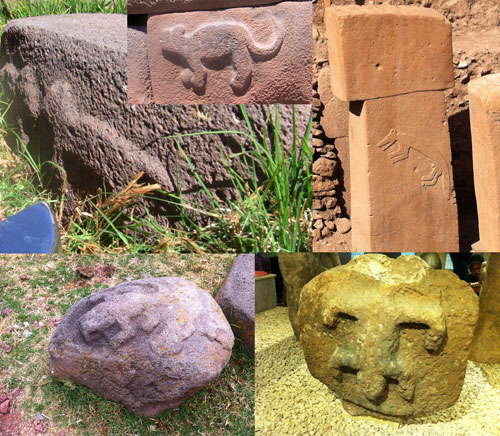
Top left: Sillustani, Peru. Top middle: Cutimbo, Peru. Bottom left: Sillustani.
Top right: Pillar at Gobekli Tepe. Bottom right: The first artifact found at Gobekli Tepe, originally thought to be Byzantium.
Perhaps as the sun revolved around the circular towers, the reliefs get exposed only at certain times of day. Could this have been a useful clock, or had some other shamanic meaning? I wonder if Göbekli Tepe was used in a similar way, as whoever repaired the site and covered it with thousands of tons of dirt, may have wanted to keep the pillars, and therefore the reliefs, in their correct position, suggesting they may hold astronomical secrets that have yet to be deciphered. It is now known that the site was significant astronomically, due to calculations made by Andrew Collins, with his colleague Rodney Hale, that will be published in Andrew’s forthcoming book ‘Gobekli Tepe: Genesis of the Gods’.
Cutimbo is another chulpa site further around the lake, about 25 km from Puno, the nearest major town. The stonework here reaches another level of complexity, with the beautiful ‘puffy’ polygonal stonework, along with some exquisite reliefs, including serpents, pumas, and even faces of creatures emerging from the rock, as though pumas (perhaps) were running towards you from the inside of the tower. Graham Hancock compared these faces to the stone ‘totem’ statue found at Göbekli Tepe, now in Urfa museum, during his lecture at the ‘Origins Conference’ in November 2013. This inspired me to look through my Costa Rica photos, because I remembered I took a photo of a statue with a similar face emerging from it’s navel at San Jose Museum.
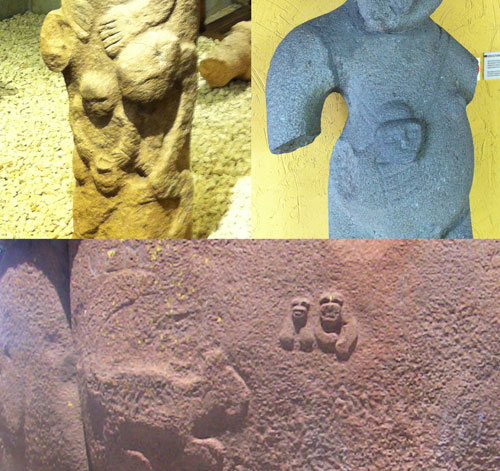
Top left: Totem statue from Gobekli Tepe. Top right: Statue at San Jose Museum, Costa Rica. Bottom: Culpa tower at Cutimbo, Peru.
Near the entrance to Cutimbo amongst piles of broken stone, a unique relief of a cheeky critter sits upon a lump of rock, that was once part of one of the towers. It looks like some kind of feline, but it’s unusual elongated fingers are an anomaly. This one resembles the creatures on the flat megalithic slabs in Costa Rica, and the solitary high-relief at Göbekli Tepe.

Top left: Close up of relief on Lapped funerary board, Costa Rica. Top right: Gobekli Tepe. Bottom left: Sulawesi, Indonesia. Bottom right: Cutimbo, Peru.
When we got back to the hotel, David Hatcher Childress showed me a copy of his popular ‘World Explorers Magazine’ with some photos of his recent trip to Sulawesi in Indonesia. I flicked through looking for further clues and the megalith statues look remarkably like ones I have seen In Guatemala and in Colombia. The quest was on. However, the last picture blew my mind, as the feline or critter of Cutimbo, had a close relation in Indonesia, this time it was on a gargantuan stone pot, with a beautifully carved lid, where the relief carvings can be seen. But it had an unusual face. The face that also features on the great megalithic statues of this part of the Bada Valley, as though it was designed to show the shamanic connection between the humans and animals. The earliest dating of the area points to a time around 6,000 years ago. The statues all have their hands on their waist pointing towards their navels and their faces and style are a close match those of San Augustin in Colombia, with some similarities to Easter Island. There are ‘elongated head’ statues discovered in all three of these places, suggesting cranial deformation could also connect these cultures. At San Augustin there is a statue that simply looks like a mini Moai, with the topknot or hat, the white eyes and a unique stance, but this one has fangs. These sites are separated by some 5000 miles across the Pacific.
At one of the platforms on Easter Island, there is a low-relief of a monkey, plus what looks like two humans (or possibly monkeys) with their hands held in the air, neatly capturing the style of Cutimbo and Göbekli Tepe. Several years ago a site in Turkey called Nevalı Çori, Turkey, dated to around 9,000 BC, has a relief carving that looks like it was created by the same artist. although this one has a tortoise or another creature lodged between the figures.
At around 10,000 years ago in this area of Göbekli Tepe and ‘the fertile crescent’, domestication of animals and agriculture was developed. Analysis of the seeds discovered from the area shows that the farming of wheat was practiced at Nevalı Çori as early as 7,200 BC (2). However, farming methods were in full swing at around 9,400 BC, with the domestication of figs near Jericho (3). In the highlands of Peru, the same skills were being practiced, at the same time. Anthropological archaeologist Tom Dillehay from the Vanderbilt University revealed that the squash seeds he found in ancient storage bins on the lower western slopes of the Andes are almost 10,000 years old. (4). He also discovered evidence of cotton and peanut farming and what seem to be garden hoes, with irrigation canals nearby (ibid). Meanwhile, at Stonehenge in England, giant wooden posts were being placed in the ground 10,000 years ago. Evidently, something was going on around the world at the end of the last ice-age, that gives clout to Graham Hancock’s theories of an advanced civilization, as proposed in Fingerprints of the Gods. However, attempting to prove what was going on at this period is beyond the scope of this article. The relief carvings found in Peru, Turkey, Indonesia, Costa Rica and Easter Island, all raise some interesting points, and certainly indicate that some re-dating may need to be carried out at these sites to get some clarity on the origins of this ancient elite.

Who these people were is difficult to ascertain, but some controversial clues have been emerging from the ground for several centuries. For example, at a site about six miles from Tiwanaku in Bolivia, a 3-foot wide ceramic bowl was discovered that shows proto-Sumerian writing, next to indigenous Aymara script. It has been labelled “The Rosetta Stone of South America". Not only does it suggest Sumerian visitors once arrived on the shores of Lake Titicaca, it has now been translated, and the dating of the use of this type of script has been dated to 3,500 BC. What does this mean? It certainly looks like there was an ancient visit by Sumerians around 5,500 years ago, and when we look at the location of where this language was being used, suddenly we see a direct connection between Tiwanaku and the builders of Göbekli Tepe and surrounding sites. (Just as a side note, the famous ‘H’ blocks at Puma Punku look a bit like the ‘H’s’ on the pillars at Göbekli Tepe. However this is a tenuous link, but worth a mention!)

The Fluent Magna bowl showing proto-Sumerian script
Arthur Posnansky the eminent archaeologist of Bolivia, dated Tiwanaku to around 17,000 years old based upon archaeoastronomy. However, since his initial deductions, this date has been revised several times, with the Fuenta Magna bowl possibly nailing down ‘a’ date at least. When you visit Tiwanaku and Puma Punku, they look like a cataclysm has given its best shot to destroy them a very long time ago, and with the evidence of advanced agriculture beginning in both South America and the fertile crescent at about the same time, we must reconsider the idea that perhaps the Fuenta Magna bowl, is in fact, just part of a long cross-cultural bond that had existed for thousands of years. An interesting pillar was also found at Tiwanaku that shows a relief of a frog, surrounded by two double-spirals, and what looks like lightning. Double and triple spirals are a symbol that has been found all over the world, most notably Malta, that has megalithic structures dating back to 5,000 BC.
In Coga Safid in the Zagros region of Iraq, and dating back to around 7000 BC an unusual elongated skull was discovered. It was one of 27 cranially deformed skulls found in the area. (5). It is one of the earliest cranial deformation examples, or an altogether unknown race, that some authors suggest were the Anunnaki from the Sumerian area. It’s dating is pretty spectacular for this type of skull. At around nine thousand years old, it is contemporary with Göbekli Tepe. It closely resembles many that have been discovered in Peru and Bolivia, including ones from Tiwanaku and Puma Punku. In fact, these long-skulls (often with trepanning) have been unearthed at almost all megalithic sites in that area. Numerous small statues found in Iraq depict thin-faced humans with very long skulls, that date to around 6500 BC. At Kilisik, a site near Göbekli Tepe , a T-shaped artifact with what looks like an elongated skull was discovered, reminiscent of the anthropomorphic Göbekli Tepe pillars, with a date of 8,000 BC. Throughout Peru and Bolivia these skulls have been found in multiple cultures at different times. The Paracas culture along the west coast seem to be the most prominent, but skulls have been found at Machu Picchu, Sillustani, Cuzco, in the northern highlands area around Huaraz, and in Ecuador, Honduras, Chile and Mexico. In Colombia multiple statues of ‘long-heads’ have been discovered throughout the country, and at the San Augustin site, some of the ferocious statues depict rather tall heads. A surprising number of skulls have been found worldwide in the proximity of megalithic sites including Egypt, Mexico, Micronesia, North America, Ukraine, France, Austria, Malta and several more. (6). The long skulls may have been a sign or royalty, or some kind of elite, and some more esoteric researchers believe it would affect the pineal gland and enhance telekinetic abilities, pushing a strange theory in to the mix of how they ‘moved’ these huge stones. In Easter Island, there is a unique solo statue in the museum depicting a very odd-looking female ‘long-head’ and the legends there state that the Moai ‘moved themselves’, or were ‘hovered’ in to place by ‘Manna’.
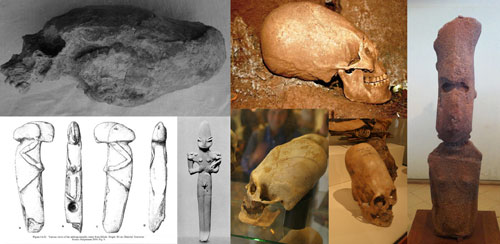
Top left: 9000 year old elongated skull from Zagros Mountains, Iraq. Bottom left: T-shaped head amulet from Kilisik, Turkey showing an elongated head. Bottom left middle: Statuette found in Sumer. Top middle: Elongated skull from Puma Punku, Bolivia. Bottom middle: Two Paracas Culture skulls, Peru (Ica Museum, and Paracas History Museum). Right: Female Moai from Easter Island, with long head.
One final megalithic connection that has mostly remained unnoticed is the tradition of leaving the ‘largest monolith in the quarry’. In Easter Island the largest Moai never emerged fully from the bedrock and can still be visited today. In Göbekli Tepe the 24ft T-shaped pillar still sits in the bedrock half-a-mile away from the site. In Egypt the biggest Obelisk in the world never made it out of Aswan granite quarry. In Baalbek, Lebanon, a 1100 ton block sits wonkily in a nearby quarry; and last but by no means least, at Ollantaytambo, not only does a nearby mountaintop quarry still have many worked blocks, but the ‘lazy stones’ that never made it up to the main hilltop site, still straddle the road between the quarry and the ruins.
It can easily be argued that these distant cultures are divided by not only space, but time, and that they would have come up with these ideas independently. I’m not so sure because carving high-relief, constructing polygonal walls, quarrying and transporting super-sized megaliths, altering skulls shapes over a lifetime (and many other points outlined above), are not things that that can be put away as simple ‘coincidences’ that any culture would just come up with, as they are all particularly difficult to achieve. Since the discovery of Göbekli Tepe, the re-dating of sites worldwide needs some more investigation, as this kind of sophistication, at this incredibly early date, could be the shake-up academia needs and may give us a new view in to our ancestral megalithic origins.
Addendum: April 14th 2014
I (Hugh Newman) also made this discovery last night (13th April 2014): The surface distance from Gobekli Tepe (name means ‘Belly/Navel hill’) to the sacred centre of the Coricancha in Cuzco, Peru (also means ‘Navel/Centre’) is the exact same distance as the equatorial diameter of the earth – 7928 miles. It is probably the diameter from the latitudes these sites sit at too. The canonical number is 7920 which can be expressed as 8 x 9 x 10 x 11 miles = 7920 miles. I find this mind-blowing as they must have known this information 12,000 years ago.
References
- A. Collins – ‘From Göbekli Tepe to Stonehenge’ DVD – www.megalithomania.co.uk
- www.ndsu.nodak.edu
- www.telegraph.co.uk/news/uknews/1520057/Was-fig-first-fruit-of-mans-agricultural-endeavours.html
- http://www.megalithic.co.uk/article.php?sid=2146413380
- http://www.iranicaonline.org/articles/prehistory-of-iran-artificial-cranial-modifications
- Childress. D.H & Foerster. B: ‘The Enigma of Cranial Deformation’ Adventures Unlimited Press
Biography
Hugh Newman is an author, conference organiser, world explorer, tour host, and Megalithomaniac. As an author he has researched the Indigo child phenomenon and published a book on the subject. His most recent book, Earth Grids has been published by Wooden Books. He has released numerous DVDs of his multi-media presentations. He has articles published in The Leyhunter, Mindscape Magazine, World Explorer Magazine, The Circular, The Spiral, The Heretic, New Dawn (Australia) and numerous other publications. As well as organising the Megalithomania conferences, he has spoken at events in the UK, Malta, France, Peru, Egypt, Bosnia and North America. He has appeared on BBC TV, Sky Channel 200, Bosnian TV and the History Channel in the last three seasons of Ancient Aliens. He is currently writing a book about the Wandlebury complex near Cambridge. Read his personal blog here and his travel blog about ‘Mounds, Megaliths & Giants of North America’.
http://www.megalithomania.co.uk/hughnewman.html. Megalithomania website: www.megalithomania.co.uk. Youtube Channel: www.youtube.com/MegalithomaniaUK






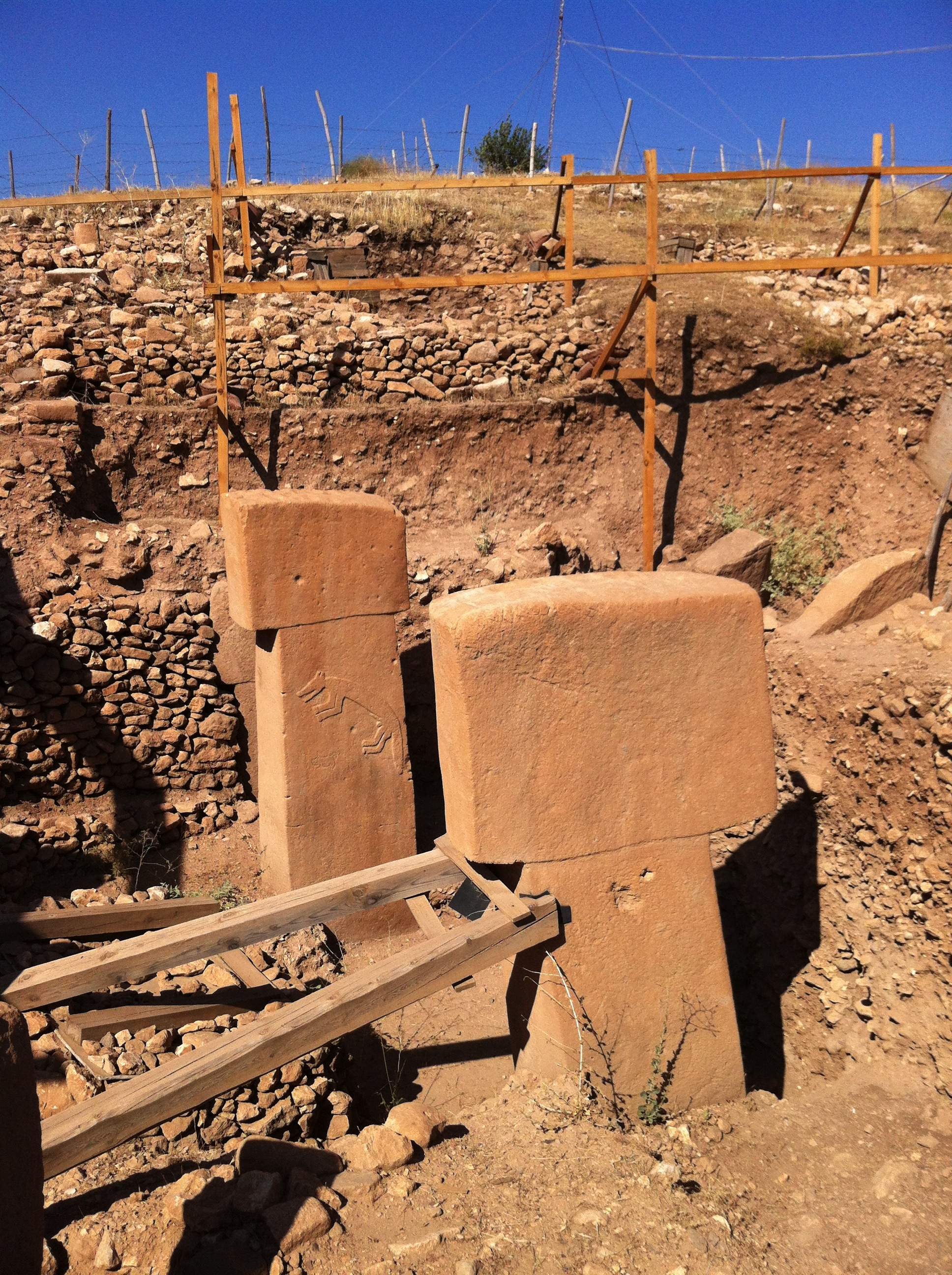


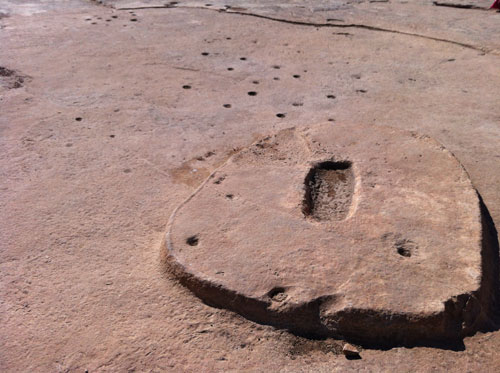

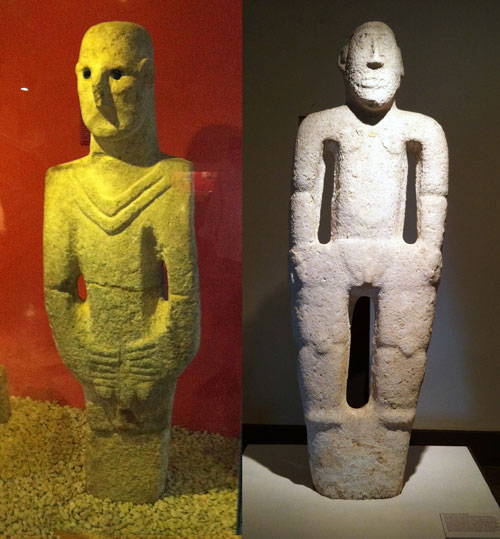
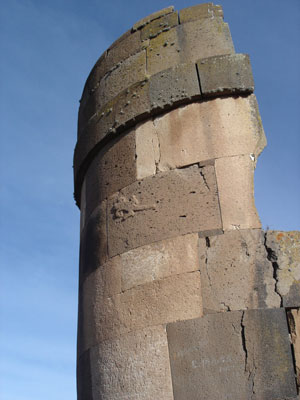
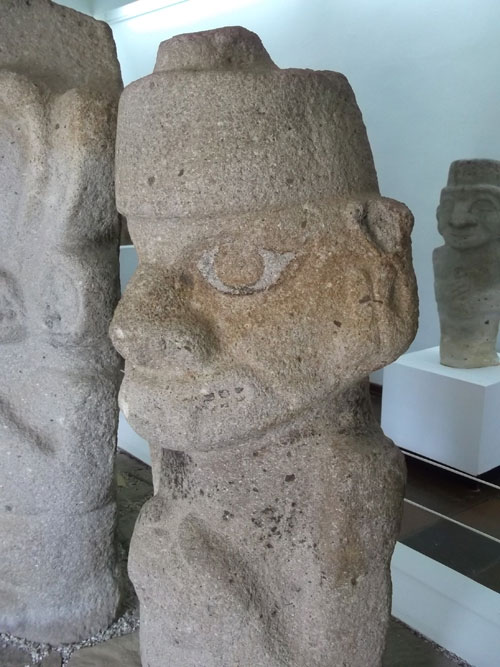
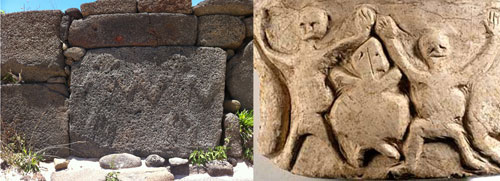
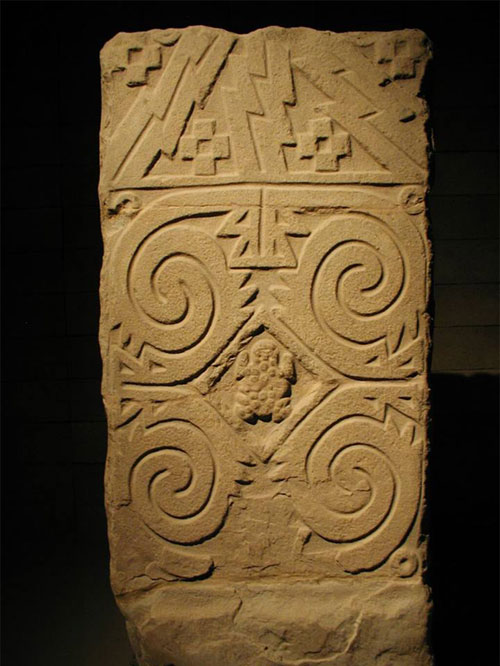

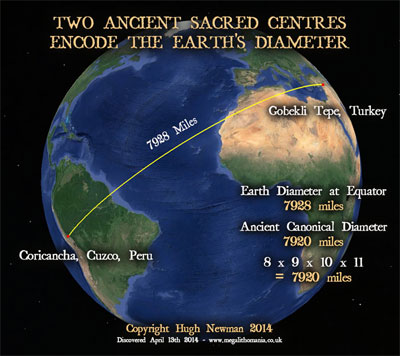


Gobekli Tepe once excavated to its original self is not “a mound or pot belly” shape. To achieve that, one must deliberately fill in the site to form the belly of a pregnant woman, or woman with child. It may be a fertility site. If so, it would make sense the distance to the Western Hemisphere to Cusco. The navel of the Earth. Two components, a mother’s womb and umbilical cord spanning the planet. I believe it is a misnomer to keep referring to Gobekli Tepe as meaning pot belly pig. Woman’s womb is more accurate. Have you noticed the monoliths of men showing the phallus and erections. It may all tie in.